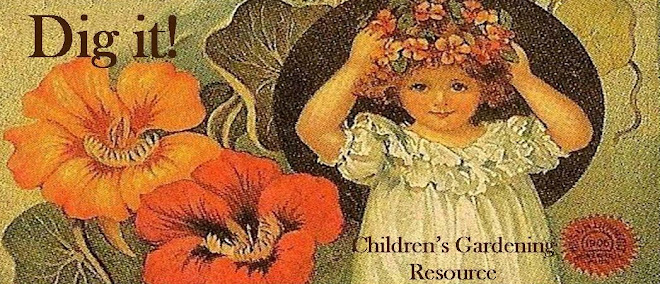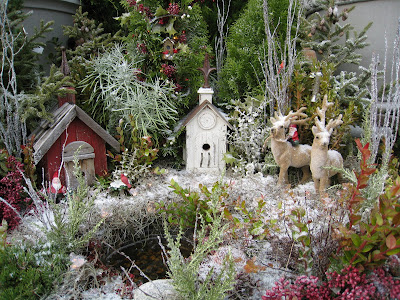
These girls are smiling, but you know what they're really thinking is, "Why is it always a marigold in a terra cotta pot?" Now, before you start sending me all sorts of nasty hate-mail, I'm challenging us to try to plant more inspiring combinations with our kids this year. Yes, marigolds are tough and relatively inexpensive, but there is a huge selection of annuals and forced bulbs available in the spring that don't really cost that much more. If the goal is to teach children to love gardening, then lets show them that there's more to gardening than a marigold in a six inch pot.

This might look pretty sophisticated but these are fairly ordinary plants, and you can easily replicate this pot. Maybe this urn isn't laying around in your shed, but who's going to notice the container when this is what you have planted inside?
- Orange tulips at the center surrounded by yellow, red and white ranunculas
- Purple viola or Johnny jump-ups at the base
- Gold Creeping Jenny (Lysimachia num. 'Aurea') and variegated ivy (Hedera helix) trail between the violets.
For instant kid-appeal, it screams with a mix of bright, happy colors. But this kind of combination gives you the opportunity to talk about bulbs and how they work, identifying plant parts, noticing differences between each plant in the pot (like the petals or the leaves), and later re-planting the bulbs in the garden.
 Here's another planted in a basket by my friend MaryBeth. Same concept: forced bulbs for height (orange tulips and hyacinth). Spring annuals include fushia stock, purple angelonia, orange callibrichoa, pansies, and variegated ivy in the foreground. Cut pussy willow stems are also stuck in here and there.
Here's another planted in a basket by my friend MaryBeth. Same concept: forced bulbs for height (orange tulips and hyacinth). Spring annuals include fushia stock, purple angelonia, orange callibrichoa, pansies, and variegated ivy in the foreground. Cut pussy willow stems are also stuck in here and there.

I love this one with the perennial in the center. This is 'Ivory Prince' Hellebore with the green blooms surrounded by pansies in antique shades of pastel yellow and mauve, and the seemingly requisite variegated ivy. This kind of combination gives us the opportunity to teach about hellebores and why we don't eat them, and more artsy concepts like texture and color.

I'm including this one because my sons like this guy (they say he's Ironman and who am I to argue). I think they might like the unfussiness of these planters, too. The crazy plant coming out of his head that looks like corydalis (although that would look great) is actually Cytisus x. spachianus or Scotch Broom. There's also a pot of clear yellow pansies in the back. This would look great stuffed with hens-n-chicks or sedums. My boys seem to love succulents.

I think, at its most basic, you'll have success if you let them choose their own pot and select the colors and types of plants. They'll love it because they planted it and hopefully take care of it. Who are we kidding? The spring containers featured above were not planted by children, but with a little guidance there's no reason why they couldn't be.

And who says it has to be JUST flowers? The little wheelbarrow above is planted with spring greens, herbs, pansies, and violas -- all edibles. Look around your yard and garage, or grandma and grandpa's for that matter. Is there an old wagon, bike, or tree stump that might make an interesting planter? I have a friend that planted sempervivens in pair of baby Crocs last year, (which have great drainage, by the way). Ask your kids for ideas.
Here are some things children can do when planting their spring container:
- Let them fill the pot with potting soil.
- Teach them how to remove the plant from its container and gently loosen the root ball.
- Help them place their flowers into the potting soil and then add more potting soil.
- Get a child size watering can so they can give their “garden” it’s first drink.
- Teach your child about what a plant needs to be happy and the importance of not over-watering.
Remember: the best thing you might grow this year is a future gardener.
 It seems like many organizations, businesses and clubs want to sponsor a children's gardening event, but struggle with the details to make it happen. Here are two simple solutions from recent events that I attended. One event was at a retail nursery and the other was a local Mom's Club Meeting. At each event, the children and parents planted an annual flower, vegetable, or seeds. One event used 6 inch terra cotta pots decorated by the child (shown above). The Moms Club Meeting used 4 and 6 inch plastic containers left over from some of my other gardening projects. Even a plastic container can be decorated. Rustoleum makes a spray paint for outdoor plastics. If you're on a tight budget, you could spray paint inexpensive pots beforehand then have the kids decorate with foam stickers from a craft store. There are hundreds of fun ways for kids to decorate a pot, whether it's painted, decoupaged, or tile mosaics but since these events were specifically designed to get kids gardening, less emphasis was placed on the container. Last year, we had the kids paint their terra cotta pots but this year we opted for self-adhesive foam stickers. This decision was to simplify the project, place more emphasis on the planting process, and create fewer headaches for parents that weren't anticipating their children to be painting that day (nothing makes a mommy more angry than paint all over an expensive outfit).
It seems like many organizations, businesses and clubs want to sponsor a children's gardening event, but struggle with the details to make it happen. Here are two simple solutions from recent events that I attended. One event was at a retail nursery and the other was a local Mom's Club Meeting. At each event, the children and parents planted an annual flower, vegetable, or seeds. One event used 6 inch terra cotta pots decorated by the child (shown above). The Moms Club Meeting used 4 and 6 inch plastic containers left over from some of my other gardening projects. Even a plastic container can be decorated. Rustoleum makes a spray paint for outdoor plastics. If you're on a tight budget, you could spray paint inexpensive pots beforehand then have the kids decorate with foam stickers from a craft store. There are hundreds of fun ways for kids to decorate a pot, whether it's painted, decoupaged, or tile mosaics but since these events were specifically designed to get kids gardening, less emphasis was placed on the container. Last year, we had the kids paint their terra cotta pots but this year we opted for self-adhesive foam stickers. This decision was to simplify the project, place more emphasis on the planting process, and create fewer headaches for parents that weren't anticipating their children to be painting that day (nothing makes a mommy more angry than paint all over an expensive outfit). After the containers are decorated and personalized, the children chose their plant (one cell of a six-pack or 4 inch pansy, veggie, or other annual). Potting soil was put into a large, somewhat shallow plastic storage bin (like those used for under bed storage). This allows easy access for several children at one time and seems to reduce the amount of mess. Kids can put their pot right into the bin to fill, or next to it, for easy clean-up. At the Mom's Club meeting, we put the bin directly onto the floor for very young participants (18 month to 3 year olds) and that seemed to work great.
After the containers are decorated and personalized, the children chose their plant (one cell of a six-pack or 4 inch pansy, veggie, or other annual). Potting soil was put into a large, somewhat shallow plastic storage bin (like those used for under bed storage). This allows easy access for several children at one time and seems to reduce the amount of mess. Kids can put their pot right into the bin to fill, or next to it, for easy clean-up. At the Mom's Club meeting, we put the bin directly onto the floor for very young participants (18 month to 3 year olds) and that seemed to work great. After they put some soil into the pot, an adult assisted putting the plant in and then the children finished adding more soil. At both events, we did not have the children water their plants to minimize the mess but advised them to water them when they got home.
After they put some soil into the pot, an adult assisted putting the plant in and then the children finished adding more soil. At both events, we did not have the children water their plants to minimize the mess but advised them to water them when they got home.














 Here's a look at the Gnome Garden in the winter. As you can see, all of the annuals and most of the perennial groundcovers have been removed (they wouldn't have survived our winter in a container anyway) and she's replaced them with cut stems, evergreen tips, and the all too necessary fuzzy fake deer and tiny gnome figures. (You have to have a sense of humor when designing your gnome garden). Although I think hers is more sweet than silly. Otherwise, the foundation stayed relatively the same. Structures, paths, and the pond remained.
Here's a look at the Gnome Garden in the winter. As you can see, all of the annuals and most of the perennial groundcovers have been removed (they wouldn't have survived our winter in a container anyway) and she's replaced them with cut stems, evergreen tips, and the all too necessary fuzzy fake deer and tiny gnome figures. (You have to have a sense of humor when designing your gnome garden). Although I think hers is more sweet than silly. Otherwise, the foundation stayed relatively the same. Structures, paths, and the pond remained. There are so many possibilities to create your own miniature garden. Let your children and their interests guide you. I've seen wonderful gardens built with train tracks winding through, but you could have a lot of fun with plastic dinosaurs, zoo animals, or giant insects. The tough part is creating something that they can play with without completely destroying or, in the case at my house, running away with all the figures. Let me know about the gnomes in your garden...and where they live.
There are so many possibilities to create your own miniature garden. Let your children and their interests guide you. I've seen wonderful gardens built with train tracks winding through, but you could have a lot of fun with plastic dinosaurs, zoo animals, or giant insects. The tough part is creating something that they can play with without completely destroying or, in the case at my house, running away with all the figures. Let me know about the gnomes in your garden...and where they live.






